QuestionThe PH level is probably low in my 90 gallon tank because I have a large aquarium piece of driftwood. It's not real. I bought it at my petstore. Also, I have 25 plants in there.
Aside from that, there is nothing else in the tank except for gravel.
In the 20 gallon tank, I have just gravel.
I will do more tests today; just to be certain and then I can always get some coral to bring it up a bit.
As usual, thanks for your advice!
-------------------------------------------
The text above is a follow-up to ...
-----Question-----
I tested my tap water. It's 7.6. My hospital tank is 7.5 and my new tank is 6.6. So this is my dilemma. I do not know what to do about the low PH level in my new tank....
I was thinking about bringing it up by gradually adding crushed coral. What do you think?
-------------------------------------------
The text above is a follow-up to ...
-----Question-----
Sorry, I have more questions. (I have never done fishless cycling before)
Firstly, do I need to leave the water to sit and cycle without changing the water on a weekly basis?
I tested the ammonia level in my new tank. It's at .50ppm. Will the ammonia go down on its own?
Also, I didn't mention that the PH level in the hospital tank is 7.5ppm and the new tank is 6.6ppm. That's why I was wondering if I should make adjustments to the PH level before introducing the fish to it. They are use to 7.5. But, as you said, goldfish can tolerate a wide range of PH level. So I suppose I could leave it.
I also did a couple Nitrite tests (as you recommended) and it is 0ppm. If I have ammonia, will/should I eventually get traces of Nitrite?
-------------------------------------------
The text above is a follow-up to ...
-----Question-----
Right now I am cycling my new 90 gallon tank. It's been cycling fishless for a week and a half. I will probably keep it going like that for another week and a half. I tested the PH levels yesterday. They are a bit lower than what goldfish thrive in.
I read it at 6.6ppm when it should be about 7.5ppm.
Do you have any suggestions for adjusting the PH higher?
I add Seachem Natural Regulator when adding water and it should adjust the PH to 7.0. I am skeptical.
Also, how long do you recommend I do a fishless cycle? (which is not entirely true, I do have a algae eater in my 'fishless' tank)
-----Answer-----
Hi Bernadette,
If you are transferring the same goldfish that you have had all these years, I would not recommend that you try to alter the pH. Read this excerpt from the Goldfish Paradise Society:
"Goldfish can tolerate a wide range of pH levels, ranging between 6.0 - 8.0. The ideal pH parameter for goldfish is generally accepted as around 7.2 pH, but I feel that the ideal pH parameter for your goldfish is whatever pH level your tap water is naturally. Like most other water parameters, it is important that you maintain a stable environment for your goldfish. Sudden swings in pH levels are harmful, and can be deadly, for your goldfish. Goldfish can thrive in a wide range of pH levels, as long as they are acclimated to it first. It is unadvisable to use chemicals and other additives to artificially raise or lower the pH level of your aquarium water, as the potential disaster of pH swings far outweigh any benefit."
The whole article can be found here:
http://www.goldfishparadise.com/water/ph.php
So, in short, I would stop using any pH regulator. Even though Seachem makes a line of fine products, this particular product may or may not work, since the "stubborness" of the pH of your water depends on other factors such as alkalinity. Even if it did work, a pH swing is going to be deterimental to your goldfish, even if it is a swing to approximate ideal levels.
Your cycling should be nearly complete. You will know it is safe to add fish when your ammonia and nitrite levels - which should be going up and then down steadily as cycling progresses - test 0 ppm, and nitrates are detectable, usually 10 ppm at first. This is from that same website as before, a section devoted to water chemistry:
http://www.goldfishparadise.com/water/water.php
That's it, good luck! Hope the oranda is better by now.
Happy new year,
Nicole
-----Answer-----
Hi Bernadette,
The crux of that article and the excerpt I quoted was that, while goldfish can tolerate a wide range of pH levels (making the pursuit of an ideal pH unnecessary) stability is the key. Read this excerpt from Peter Hiscock's book, Encylopedia of Aquarium Plants, regarding pH:
"The pH scale is logarithmic, meaning that each unit change in pH, say from 7 to 8, is a ten times change. A change of two units from 7 to 9 is a hundred times change, and from 7 to 10 reflects a thousand times change. This is why a sudden change in pH is very stressful and harmful to fish."
Also read this excerpt from freshaquarium.about.com:
Should You Alter pH?
The million-dollar question is - should you alter the pH of your water? A general rule of thumb is whenever possible leave well enough alone, as it's not easy to change the pH and keep it that way. It is more important to have a stable pH than one that perfectly matches the textbook requirements for your fish...Always proceed cautiously when altering pH.
...I do not advise the use of commercial pH up or down preparations to alter pH on an ongoing basis. They are not designed to make a long-term change. Instead, look at methods that are don't require frequent adding of chemicals to maintain the desired pH..."
Your dilemma now is that your hospital tank water is almost ten times more alkaline than your main tank's water. This is too big a difference. When you get ready to transfer your fish, you will have to make certain that the new water is not so different a pH. While goldfish are adaptable in what they accept for pH, a pH swing is just as stressful for them as any other fish. It's like going from a hot bath into freezing snow...
What I would recommend is changing the hospital tank water with dechlorinated, but otherwise untreated, tap water, so that it is gradually brought down to "normal" - I presume your tap water's ph is 6.6? (By the way, pH is just a number, it is not measured in parts per million, ppm.)
When the pH is nearly the same in both tanks after diluting the hospital tank with dechlorinated, but otherwise untreated water, and the nitrites and ammonia are not detectable at all - and nitrates present themselves - then you are ready to transfer the fish. My recommendation based upon years of experience and reading are to slowly wean yourself off of chemical pH additives: they promote unstable water conditions, and instability is always undesirable.
This website discusses this further:
http://www.firsttankguide.net/ph.php
Ammonia levels at .5 ppm in your tank are unsafe for any fish, even your algae eater, Bernadette. Ammonia is the very first step in the nitrogen cycle. Ammonia is converted to nitrite, which is then converted into nitrate. Regardless of how long your tank has actually been up and running, it is still brand new as far as water quality goes. Water changes would not be necessary in your tank - if your algae eater weren't in there! Water changes in a cycling tank prolong the cycling process. Here's another excerpt:
"The first component needed in the chain is ammonia, and it is only during the cycling process that ammonia readings should be present in an aquarium. Once ammonia begins to accumulate in the aquarium, the process begins. So where do you get the ammonia from? It is produced by such things as fish and other livestock waste, excess food, and decaying organic matter from both animals and plants. Now putting live animals into a tank for the purpose of cycling is not easy, because they are exposed to highly toxic levels of ammonia and nitrite during the process. However, without ammonia present the cycle cannot begin, and if ammonia is removed, or the supply is disrupted during cycling, the process stops. As you see the ammonia level rise during the cycling period, if you think by adding an ammonia destroyer or doing a water change to bring it down is helping, it isn't! You are only delaying the cycling process and preventing it from completing its mission. If you use fish to cycle an aquarium, it's a catch 22! You don't want to put the animals in harms way by exposing them to toxic elements, but you need their waste as the ammonia source to get the job done. The good news is there are alternatives to cycling a new tank without having to use fish, as well as ways to help speed up the nitrogen cycling process..."
You should be using your old filtration media from your hospital tank as well as gravel from your hospital tank to "seed" your tank. Not fish - otherwise you are not fishless cycling! You can buy bacteria starters also, BioSpira being the only one that will cycle your tank instantly.
So the answer to your question is yes, your ammonia will go down, eventually, but not before it comes up. Dangerously up for any living inhabitants in the tank while it is cycling. Although water changes will delay the cycling process they will be necessary if livestock is present in the tank being cycled. As I mentioned, .5ppm is already toxic, any higher and there is a real risk of ammonia poisoning.
A fish is not necessary to introduce ammonia into the tank. A small piece of cocktail shrimp left in the tank OR a few flakes of fish food sprinkled once daily will provide all the "starter" ammonia that is needed for the cycling to begin. Now that is what fishless cycling is all about!
I hope that answered your question. The referenced reading material is going to be very helpful to you in understanding the process better. Keep reading, Bernadette, and you will have the answers!
Nicole
-----Answer-----
Hi Bernadette,
Using crushed coral or crushed oyster shells is an excellent idea to raise pH naturally and gradually. I would try it.
You should determine what is making the pH so much lower in your newly setup tank. Do you have driftwood in there, or other pH lowering decorations? Think about why your pH what it is in your newly setup tank, there must be something different about it compared to your 29 gallon.
Nicole
AnswerHi Bernadette,
If the driftwood is made of resin (like a fake decoration made to look like real driftwood), it isn't going to affect your pH because the resin it is made from is inert. Only real driftwood will lower pH and stain your water yellowish, like the color of weak tea. Many aquarium bought pieces are already boiled and treated so that they will not change the color of the water but will still have a pH lowering effect.
Peat does the same thing - it acidifies the water by leaching tannins into the water. Peat filtered water has been used by aquarists who like this "Amazonian" effect. There is even an extract (called blackwater extract) you can add to the water to condition fish who prefer acidic water into spawning - angelfish for example. Just an aside!
The live plants - you meant live plants, right? - are probably the reason for the pH difference. Are you fertilizing the plants using CO2 or liquid fertilizers? Do be careful, if the pH drops when the goldfish are in there you will see some unwanted side effects. Also, don't goldfish love to eat live plants? :)
Good luck!
Nicole

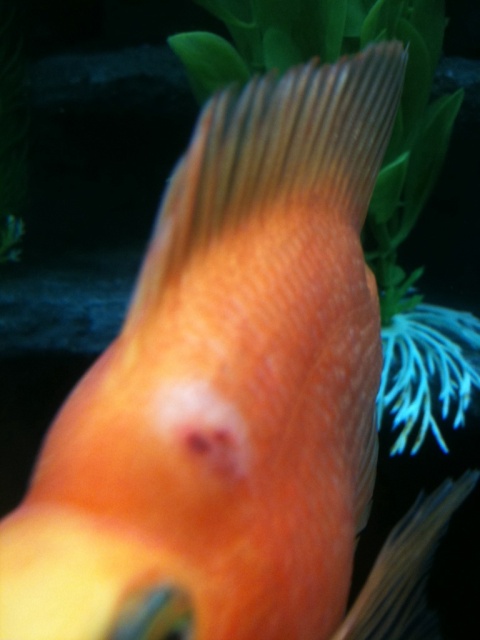 Blood red parrot has a swollen red spot
QuestionQUESTION: I have a 55 gallon tank nine fish inc
Blood red parrot has a swollen red spot
QuestionQUESTION: I have a 55 gallon tank nine fish inc
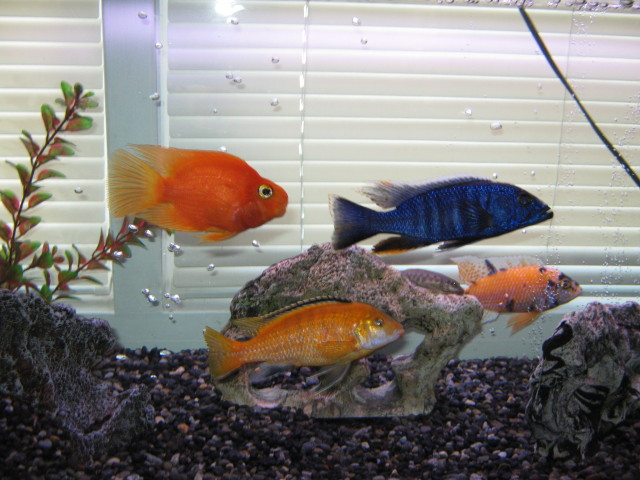 Cichlid males exhibiting mating behavior with each other
Question
My cichlids
Hi, I have 4 cichlids in a 30 gall
Cichlid males exhibiting mating behavior with each other
Question
My cichlids
Hi, I have 4 cichlids in a 30 gall
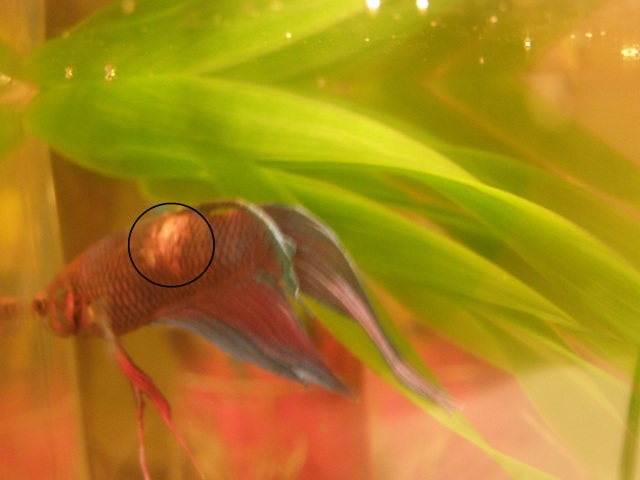 Sick bettas
QuestionPico
QUESTION: Hi Jaymie,
My roommate
Sick bettas
QuestionPico
QUESTION: Hi Jaymie,
My roommate
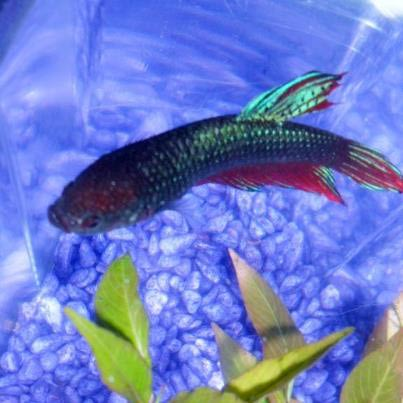 Betta Fish - Care Question
Question
Spike
Hi, First of all I want to thank
Betta Fish - Care Question
Question
Spike
Hi, First of all I want to thank
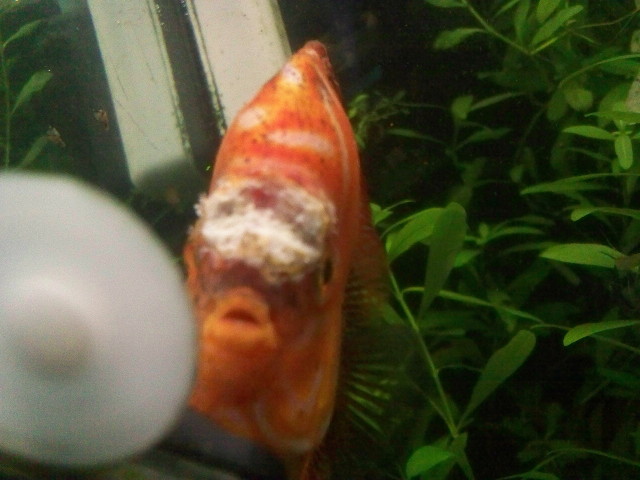 Discus Open Wound
QuestionDiscus Sore
QUESTION: Hello,
My 2 year o
Discus Open Wound
QuestionDiscus Sore
QUESTION: Hello,
My 2 year o